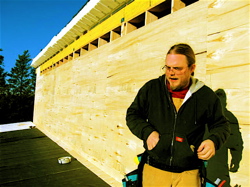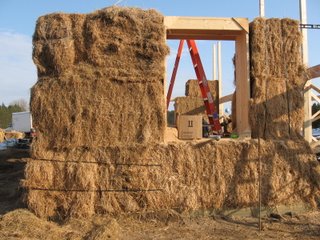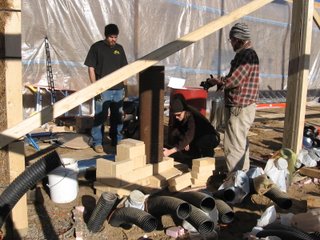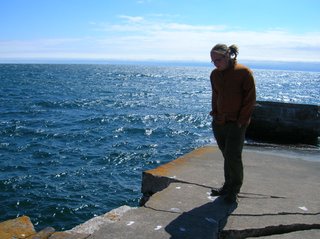Well, it's been more then a month since my last post, and I apologize for that. I've been busy. Last night I went to a going-away party for my friend Krista (sustain-this.blogspot.com) who is is going to California to pursue her Masters degree, and that was fun. We drank tasty good homebrew that I participated in brewing. It had a whole pound of hops added. Very biscuity.
I would add photos to the following but I can't find the cord that connects the camera to the computer so you'll just have to take my word for it for the time being.
First of all, living with a group of strangers is odd. I've become somwhat acquainted to them, but you never really know who they are. I live with my boss who is 30ish lawyer/green builder woman, and the other interns Jesse, 30ish hippy Bahai cabinet-maker man, and Phyllis, 40ish insomniac builder/designer woman. We make a strange team, but we can actually get some things done sometimes. There was actually another intern but he gave up after a month. He was a carpenter for Habitat for Humanity, and he talked in a Clint Eastwood drawl and wore black work clothes. I called him the Carhart Ninja.
The house where we live is relatively large. It's on the market so it's pretty empty of furniture. The heat seems to be cranked to the max even though I've turned the thermostat in the basement to zero, and when every body gets bundled up for the days work in the morning, we all overheat and start to sweat. The boys are in the basement and the girls up in the normal part of the house. One day I was snooping around and I found a piano in the boiler room and then another room adjacent filled with pails full of staple every day items like corn and diapers. End -of-the-world room, I guess.
I don't have a a bed or any furniture, so I sleep on a futon and create back problems for myself.
I'll focus on the actual building of the strawbale house, and write entrys for side projects and other assorted topics later.
We started out with an empty space, just a big chunk of sand. Then a contractor came in and dug out a hole, about 45' by 25', long axis facing south, two thirds of the north side about 3 feet deep, the south side about 5 foot deep (where we were going to put the greenhouse). The contractor put in our septic system, then we spent a few days learning the ins and outs of a batter board type system, trying to get the foundation staked out and ready for construction. Let me tell you that staking out a house is no easy thing. Creating a perfect rectangle in sand with rebar stakes is like trying to eat with your mouth full. But on day we got it down, and we were ready to proceed.
I forgot to tell you that before all that we sat down with the boss and she said that we were going to get a giant 60'x100' tent that we were going to put over our work area adn that we had to build giant wooden skis for it and it might take a few weeks to put up. I felt like that was a waste of our time and said as much. To weigh down this giant structure we went out and cut the tops of 45 plastic totes with a Sawzall, got the Bobcat revved up and filled them up with sand so that they weighed a couple tons each. It was the weirdest task I have ever done. But I like learning how to use the Bobcat, it was as if I was in a Mechwarrior video game, and I had the ultimate power to crush and move and grade. Then we had to move them off the field because the contractors came in to put in the sewer and level the ground.
We also learned that we were going to be building with giant (8'x3'x3', 700 lbs) bales of flax straw, and that we were going to be putting a giant bale living roof on our structure. This sounded amazingly ambitious to me, considering we had to months and we had to construct a giant tent with cranes first. After debate and a couple weeks went past, the giant tent idea was discarded as well as the giant bale living roof system. We were now going to use SIPs panels for the roof, but of course no ordinary SIPs, which are usually a rigid insulation encased in two layers of OSB or plywood, we were using a SIPs that was a partial metal interior inside two layers of rigid insulation.
So in the final analysis, the house we are building consists of a tamped earth foundation with a treated 2x12 toe-ups filled with stone under the giant flax strawbales on the west, east, and north sides of the building. The south side consists of post and beam construction for the greenhouse which will have plastic glazing. The structure will be precompressed with plastic strapping material and the SIPs panels will be mounted on the walls for the roof. There will be solar water heating collected from the roof by refurbished solar panels and circulating throughout the pex laid out in the earth under the cob floor, and their will be a modified heat sink utilizing black drain-tile laid out 5 feet deep in the greenhouse floor. Ther will also be a rocket stove for back-up heating. The inside and outside walls will be cob. There will be a composting toilet. We have been using biodiesel for running a lot of the machines we use.
Now, each of these components could be discussed at length, and sometimes it's hard to focus on one thing at a time. My guess is that you don't know what cob is, because I barely did until I started this internship.It is just a mixture of clay, sand, and straw. It is a very natural and versatile material. The clay is the basic medium, the sand prevents shrinkage and provides strength, and the straw provides an interwoven matrix and structural reinforcement. It is like natural concrete. I have seen many things made out of it, including walls, floors, coat hangers, and dragons. As a structural component it provides mass, and it breathes well, which is important in strawbale construction because you don't want to trap moisture inside the walls and provide a breeding ground for molds.
I'm going to stop here and get back to you later. It's Sunday and I have to do chores and get a breakfast in me before heading back to the north woods. Any questions so far?




























All your points are silly. Let's take them one by one.
1. How is it better to support your local economy then the poor Chilean farmer? Is an American better somehow? Is someone who lives close to you better?
2. If the product is being made in Chile there is even less harm to the local watershed then if it is grown by a local organic farmer.
3. The vegetable is probably fresher, but that doesn't necessarily mean it is any more nutritious.
4. You will only save a small amount of petrolium products for your vegetable. Large ships use a lot of oil, but they also carry huge ammounts of produce.
5. Your local farmer care no more about you than the large corporation. They're both in it for the money. But the local organic farmer asks for more of your money.
Also, you say that food co-ops were started to help poor people. If that was the case, it is no longer. They are the gathering places of snobs.
Give me a big Safeway or Albertsons any day.
4:33 PM
Noah, why do you prefer a Safeway or Albertson's to a small co-op or grocery store? Is it because you like being the anonymous shopper, you like the giant buildings pulsing with wasted energy, the glib and unresponsive staff...You need to reevaluate why you prefer a giant box store before I can really debate you about local organic agriculture. You want to pay 5 cents for an apple from mexico? Go ahead and suck down those pesticides and herbicides, go ahead and feel happy about subjecting those farmers to these chemicals. Your points are not thought out:
1. It is better to support your local economy because that is where you live. Don't you want to support your neighbor, build a relationship with the farmer, recirculate your "hard-earned" cash in your town? this has nothing to do with being "better".
2. There is no harm to the local watershed when a product is farmed organically. None.
3. Fresher vegetables are better for you. There are more enzymes and vitamins. This is a scientific fact.
4. You don't honestly believe this? The farther away a vegetable comes from the more fuel is used in getting it to your plate.
5. The small local organic farm cares about the community and the earth. There is no other reason to get into organic farming. There is not alot of money in it. The farmer might as well work at UPS and get health insurance and a decent wage, rather then work their ass off every day for no money and no insurance.
I said in my blog that the co-ops were started to help the poor get bulk commodities, and now they have turned into rich peoples dietary centers. But I think it's important to support them anyway, the same reason I think it's important to support your community even if you think it's full of assholes. Only you can be the change.
1:05 PM